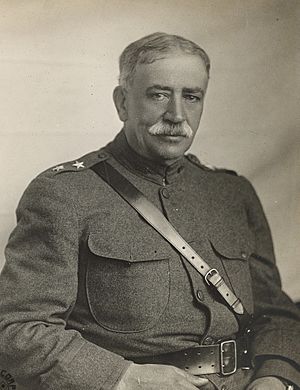Edwin Forbes Glenn facts for kids
Quick facts for kids
Edwin Glenn
|
|
|---|---|

Major general Glenn as commander of the 83rd division, Langres, June 1918
|
|
| Born | January 10, 1857 Greensboro, North Carolina |
| Died | August 5, 1926 (aged 69) Glendon, Moore County, North Carolina |
| Allegiance | |
| Service/ |
|
| Years of service | 1877–1919 |
| Rank | |
| Service number | 0-13126 |
| Battles/wars | World War I |
| Spouse(s) | Louise Smythe |
Edwin Forbes Glenn (born January 10, 1857 – died August 5, 1926) was an important officer in the United States Army. He served in the late 1800s and early 1900s. He played a role in World War I and held many different positions during his career.
Contents
Discovering Edwin Glenn
Edwin Forbes Glenn had a long and interesting career in the United States Army. He started as a young officer and rose through the ranks. His journey took him from frontier duties to teaching and even to serving in a major world war.
Early Life and Education
Edwin Glenn was born near Greensboro, North Carolina, on January 10, 1857. He attended a private school for boys in North Carolina. Later, he went to a special preparatory school in New York.
After his schooling, he joined the United States Military Academy. This is a famous school for training army officers. He graduated from West Point in 1877.
His Military Career
After graduating, Glenn became an officer in the 25th Infantry Regiment. For about 11 years, from 1877 to 1888, he worked on the American frontier. This meant helping to keep peace and order in new territories.
Different Roles and Places
In 1888, Glenn took on a new role at the University of Minnesota. He became the first professor of Military Science and Tactics there. He also taught mathematics to students. During this time, he studied law and became a lawyer in Minnesota.
He then worked as a legal advisor for different army departments. These included the Department of the Dakota and the Department of the Columbia. He also led rescue and exploration missions in the District of Alaska.
In 1900, Glenn went to the Philippines as a legal advisor. While there, some of his actions during missions were reviewed. He later commanded the Columbus Barracks from 1905 to 1907. After that, he returned to the Philippines with the 32nd Infantry Regiment. He stayed there until 1913.
Glenn continued his education at the United States Army War College in 1913. After finishing, he became the Chief of Staff for the Department of the East. From 1916 to 1917, he commanded the 18th Infantry Regiment. He also led the First Separate Brigade at Camp Cody.
World War I and Retirement
As World War I began, Edwin Glenn was promoted. He became a brigadier general on May 15, 1917. Then, on August 5, 1917, he was promoted again to major general. He helped create and lead the 83rd Infantry Division. He commanded this division from August 1917 to January 1918.
For his service, he received the Legion of Honour. This is a very important award from France. After the war, in 1919, he oversaw the closing down of Camp Sherman in Ohio. He officially retired from the army in December 1919 as a brigadier general. Years later, in June 1930, Congress recognized his higher rank and restored his title of major general.
Beyond the Military
Besides his army work, Edwin Glenn was also involved in other activities. He was one of the early leaders of a group that later became the Association of the United States Army. He served in this role from 1913 to 1920.
He also wrote two books. The first was called Glenn's International Law, published in 1895. His second book, Rules of Land Warfare, came out in 1914. These books showed his knowledge of military law and strategy.
Personal Life
Edwin Glenn married Louise Smythe early in his military career. They met while he was doing frontier duty. After he retired from the army, Glenn lived in Glendon, which is in Moore County, North Carolina. He passed away there on August 5, 1926.

